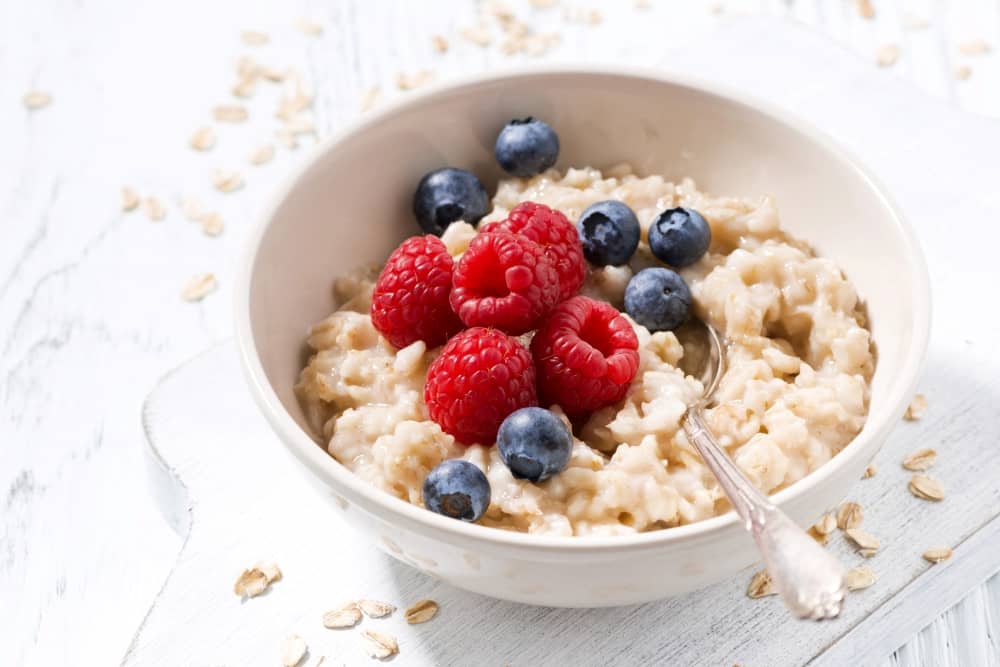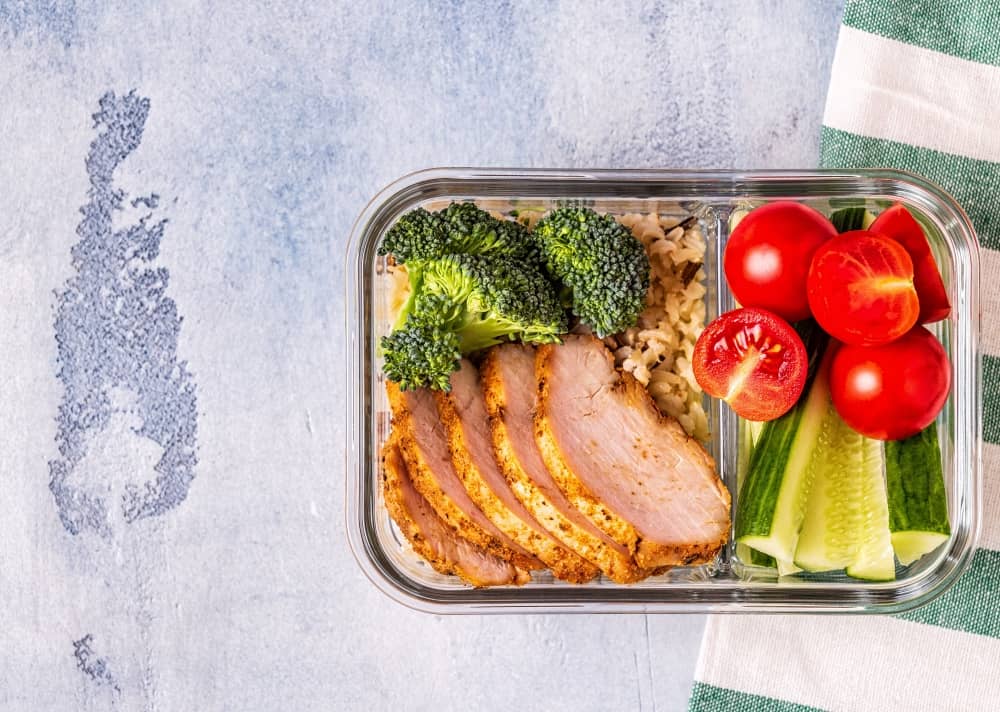We’ve put together a complete guide on your diet while practising Pilates, including when to eat, what to eat before and after a Pilates class, the importance of staying hydrated during workouts and pre and post-workout snack and meal ideas.
When to Eat Before Pilates Class
The timing of pre-workout meals is just as important as what you eat. You don’t want to head to class with a large meal that isn’t completely digested. Trust us, hundreds are not fun after a heavy meal!
Although the best time to eat before a workout depends on the individual, there are some general guidelines to follow. Try to avoid eating anything within an hour of your class. You may even want to leave two hours between eating and your Pilates class.
Practice different timing and different food combinations to see what works best for you.
What to Eat Before a Pilates Class
Eat too little before a Pilates class and you may feel light-headed or low on energy. Eat too much and you may feel lethargic and bloated.
Here are some tips to keep in mind when deciding what to eat before a Pilates workout:
- Stay away from foods that may cause gas or bloating (i.e. cabbage, onions, lentils, beans, cauliflower, broccoli, and garlic)
- Avoid foods that are heavy or take a while to digest
- Avoid foods that are high in sugar or carbs
- Avoid large meals or greasy foods
- Avoid foods that are high in sugar and carbs as they will cause your blood sugar levels to spike and then crash, leaving you low on energy
Instead, focus on a light meal or snack that includes a little healthy fat, lean protein, and complex carbs. This combination will keep you fueled up and help support balanced energy levels to allow you to push through the class.
For early morning Pilates classes, keep it light and opt for a combination such as a small bowl of yoghurt topped with nuts and berries or a banana with nut butter.
For afternoon Pilates classes, an energy-dense breakfast such as an omelette topped with avocado and salsa will leave you satisfied and full of balanced energy.
Here are a few healthy pre-workout snacks and meals you can eat an hour or two before your Pilates class:
- Scrambled eggs with avocado and a handful of berries
- Unsweetened yoghurt topped with berries and nuts
- An apple with nut butter and a small cube of cheese
- A salad featuring dark leafy greens and topped with nuts and a diced boiled egg
- A lettuce wrap with a form of lean protein such as sliced turkey
- A banana topped with almond butter
- Celery topped with hummus
- A green smoothie with leafy greens, half a banana, a handful of berries, and a scoop or two of unsweetened, plain yoghurt
- A protein bar (pay careful attention to the ingredients to avoid bars that are packed with added sugar or preservatives)
- A high-quality protein shake (again, pay close attention to the ingredients)
- A small bowl of oatmeal topped with a handful of berries
- Nut butter on sprouted, whole grain toast and a handful of baby carrots or berries
When to Eat After Pilates Class
It is important to eat a small meal or snack around 30 to 60 minutes after your Pilates workout. This helps replenish your body’s glycogen stores and provides your body with the lean protein it needs to repair your muscles.
What to Eat After Pilates Class
Similar to a pre-workout meal, you’ll want a combination of lean protein, healthy fats, and complex carbs.
Here are some easy, healthy post-Pilates meal ideas:
- A protein shake made with a high-quality protein powder and healthy ingredients
- A bowl of plain Greek yoghurt topped with fruit and nuts
- A bowl of oatmeal topped with berries and served with a boiled egg on the side
- A veggie-packed omelette featuring spinach, asparagus, onion, mushrooms, bell peppers, and black olives and topped with diced avocado
- Sweet potato with a side of fish or grilled chicken
- Grilled chicken with a side of brown rice and a non-starchy vegetable
- A salad with diced boiled egg, pistachios, bell pepper, sunflower seeds, and any other of your favourite veggie toppings
- A veggie-filled bean soup with a slice of sprouted whole-grain bread on the side
- A smoothie featuring yoghurt, berries, a scoop of nut butter, and a handful or two of spinach
What to Eat In Between Pilates Workouts
Your diet between Pilates workouts will depend on your goals and your specific body type. Maintaining a balanced diet will help you build long, lean muscles and keep your energy levels consistent so you are always ready for your next workout.
Aim to eat a diet rich in nutrient-dense, whole foods, including:
- Nuts, seeds, and nut butter
- Healthy fats from wild-caught fish (sardines, salmon, tuna, anchovies)
- Unsweetened yoghurt
- Fruits
- Vegetables
- Leafy greens
- Whole grains (old-fashioned oats, millet, brown rice, barley, quinoa)
- Lean protein from chicken, turkey, fish, full-fat dairy, and eggs
With anything, moderation is important, so be sure to avoid getting too restrictive with your diet. Include a high-quality dessert now and then to maintain balance and ensure success in the long run.
The Importance of Hydration
When you sweat, you lose fluid from your body. These fluids need to be replaced through adequate hydration.
If you don’t drink enough fluid during workouts you may experience more fatigue than usual, impaired thinking, slower body functions, and reduced athletic performance.
The benefits of staying hydrated during workouts include:
- Maintain performance levels and body function
- Reduce your risk of heat stress
- Help prevent your heart rate or body temperature from becoming too high
- Increase your endurance
- Improve your concentration
- Maintain blood volume
- Support the body’s natural detox mechanisms
- Support energy levels
- Increase your aerobic capacity
To stay hydrated during your workout, aim to drink at least one 8-ounce glass of water half an hour before your Pilates class. Keep a water bottle near you in class to sip as needed.
After your Pilates workout, you need to drink more fluid than your body lost during your workout. Aim to drink at least two cups of water (16 ounces) within 30 minutes to an hour to ensure proper hydration. Fruits and vegetables with a high water content can also count toward your hydration goals.
Should I Carbo-Load Before a Pilates Class?
Pilates can be intense and certainly challenging, but it does not require the same energy as running long distances or intense, long workouts. Although it can be helpful to eat some healthy carbohydrates an hour or two before class to keep your energy levels up, there is no need to carbo-load.
Do I Need a Sports Drink for Pilates Class?
Pilates can be a challenging, intense workout but it does not usually require a sports drink. If you do choose to consume a sports drink, pay attention to the amount of added sugar.
Sign Up for a Perth Pilates Class
We offer a wide range of Pilates classes, from Pilates for beginners, Reformer to Boxilates, and TRX. We’d love to have you join us for a session!
If you have questions about our different Pilates classes or would like to sign up for a session, contact us or use our convenient online scheduler to book a class.


